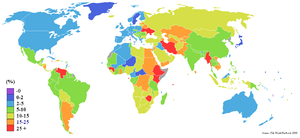 Image via Wikipedia
Image via WikipediaAn April 5, 2011 press release by the National Economic and Development Authority
Slow growth in clothing prices and the reduction in electricity charges maintained headline inflation at 4.3 percent for March 2011, according to the National Economic and Development Authority (NEDA).
“Higher annual growths in services and miscellaneous commodity prices was offset by slower annual rates in the clothing and fuel, light and water index,” said NEDA Deputy Director-General Rolando G. Tungpalan, currently officer-in-charge.
The slow growth in electricity prices was mainly due to the 1.62 centavos per kilowatt-hour (kWh) decrease in generation charges of the Manila Electric Company or MERALCO in March. From P4.8623/kWh in February, generation charge went down to P4.8461 the next month. Increase on clothing prices also slowed to 1.8 percent from 1.9 percent in March.
The March 2011 inflation rate is the same as in February 2011and is lower than the 4.4 percent registered in March 2010. “The average inflation rate for the first quarter of 2011 is 4.1 percent, which is still within the Development Budget Coordination Committee target of 3-5 percent for the year,” he said.
Compared to a year ago, prices of fruits and vegetables (12.8%), water fees (9.9%), fuel (9.7%), transportation and communications (8.3%), and miscellaneous foods (7.1%) increased.
The prices of unleaded gasoline, kerosene, diesel oil and liquefied petroleum gas or LPG increased by an average of 0.42 centavos in March, which is higher than the 0.08 average increase in the previous month.
“This is a result of domestic pump prices reacting to the high and volatile international crude prices that is expected to affect global food prices,” Tungpalan explained.
Meanwhile, inflation in areas outside of the National Capital Region (AONCR) stood at 4.5 percent, higher compared to NCR’s 4.0 percent.
Responding to mounting inflation pressure, the Monetary Board of the Bangko Sentral ng Pilipinas (BSP) raised policy rates by 25 basis points for the first time since July 2009.
“The increase in policy rates was prompted by price pressures, particularly from the continuing geopolitical tensions in the Middle East and North Africa, coupled with the steady demand for oil despite the calamity-induced reduction in Japanese petroleum demand,” Tungpalan said.
The BSP increased policy rates due to increasing concerns over prices accelerating further and the latest baseline inflation forecasts that currently indicates that the 2011 inflation target range could be at risk.
Indonesia and Thailand also adjusted their policy rates. Indonesia raised its policy rates by 25 basis points to 6.75 percent in early February while Thailand increased also by 25 basis points to 2.5 percent effective March 23.
In March 2011, Thailand’s inflation rate inched up to 3.14 percent from the previous month’s 2.87 percent while Indonesia’s inflation rate slightly eased to 6.65 percent from February’s 6.84 percent.






No comments:
Post a Comment